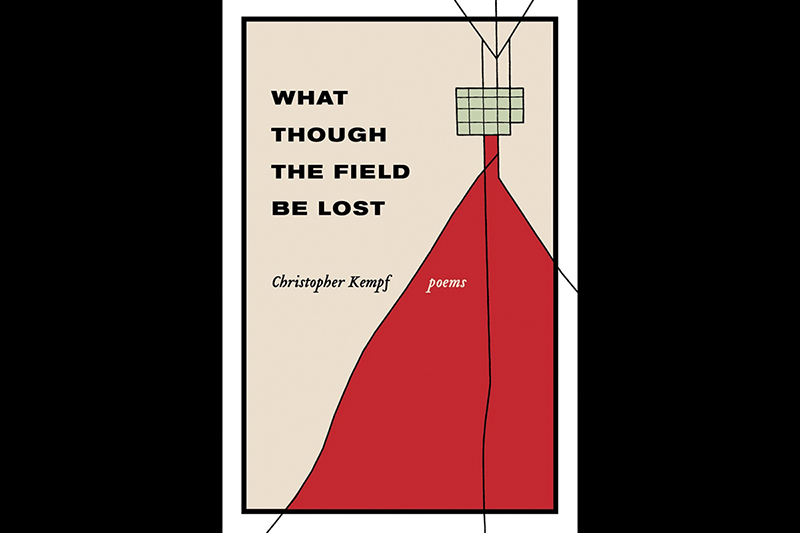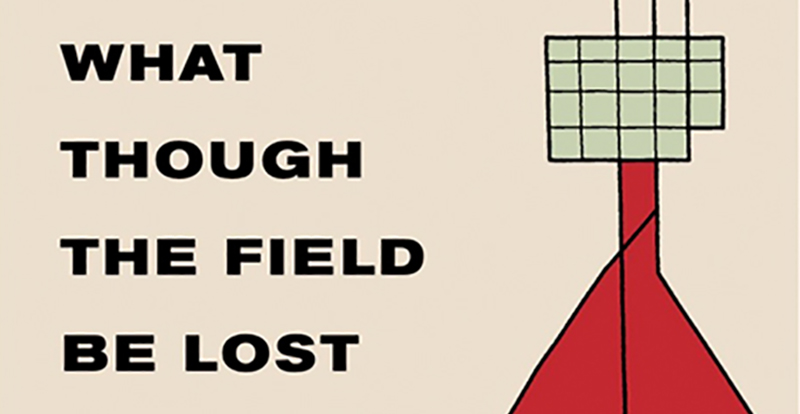If you’ve ever visited a battlefield or war monument, you’ve felt the difference in the air, and in the very energy surrounding it. Like any external or internal site of trauma, it is fraught with memories of pain, loss, and transformation. It echoes with complex and often contradictory narratives of its past, present, and future. In his recent collection of poetry, What Though the Field Be Lost, Christopher Kempf investigates one of the most fraught sites in our country’s history and in our national psyche: Gettysburg, Pennsylvania.
Kempf is a literary triple threat. He holds a Ph.D. in English Literature from the University of Chicago, an MFA from Cornell University, as well as deep understanding of history, and the significance of how it is told. His bona fides include a Pushcart Prize, a National Endowment for the Arts Fellowship, and a Wallace Stegner Fellowship from Stanford University. His work has appeared in a range of prestigious journals including Best American Poetry (2020), Boston Review, Georgia Review, Gettysburg Review, Kenyon Review, New England Review, The New Republic, and PEN America. And when he’s not writing poetry or creative non-fiction, or teaching at the University of Illinois’ MFA in Creative Writing program, he is pursuing scholarly research that “focuses on the interrelation between work and writing.”
But these achievements are not merely milestones in what is already an impressive career. Kempf’s mix of interests, experiences, lived and academic, place him in a unique position from which to investigate Gettysburg in both its physical and mythic realities. What Though the Field Be Lost, based on “two years living and researching in Gettysburg, Pennsylvania,” “interrogates the rhetorical construction of the past at sites of public remembrance, ” by using the battlefield there as setting and subject for poetry that engages ongoing conversations about race, regional identity, and the ethics of memory in the United States.”

Photo courtesy of Christopher Kempf.
As a student of literature, I may be biased here, but one of my initial thoughts early into my reading of this collection was this: Poetry is a powerful tool for examining our nation’s history. It was a similar feeling to the one I had watching Amanda Gorman read at the recent Presidential Inauguration. Poetry transports us into the emotional depths and small but significant details of history. What Though the Field Be Lost invites us into a kaleidoscopic reexamination of our nation’s earliest and deepest trauma. A wound that remains unhealed.
Poets and historians alike must choose a tactic upon entering the critical field, especially when that space is as charged as Gettysburg. Gettysburg signifies a historical loss of lives, as well as our complicated relationship between race and national identity, between war and memorialization. Kempf deftly chose the Cyclorama as both an overarching metaphor and narrative strategy. Considered “the must-see entertainment of the 1880s, cycloramas were the blockbuster movies of their time. Often depicting epic battles or historical places, the enormous, paintings-in-the-round transported viewers into the middle of the fray; surrounding them with a 360-degree, hand-painted canvas longer than a football field and higher than a four-story building.” According to Gettysburg Foundation website, The Battle of Gettysburg Cyclorama, created in 1884, by French artist Paul Philippoteaux, “With its landscaped foreground and dramatic sound and lighting effects, the Battle of Gettysburg still creates the three-dimensional illusion of being in the midst of the battle. It is an immersive experience today’s visitors call ‘moving,’ ‘riveting,’ and ‘breathtaking.’”
Srikanth Reddy, author of Underworld Lit, described What Though the Field Be Lost, as a “guided tour through the tragic cyclorama of American history. Revisiting, revising, and reforming constructions from Milton to Whitman to the Southern Agrarians and beyond, [Kempf] refuses to ‘plant plastic flags for Gettysburg’s fallen” when more reparative futures await our construction.”

Image from Christopher’s Kempf’s website.
Many of the poems, and their titles, play with familiar Gettysburg tropes. The collection, like the many sports-as battle-images it conjures, begins with a “National Anthem.” This hopeful and somewhat surrealist reimagining of what our nation could look like if it were to recover from its deep-seated needs for war, violence, and devisiveness.
“If, then, a country could be saved, may we
all be its pulse & schematics. May our flags
kneel for us. May nothing reign.•
May guns gather bullets
back into themselves like fishing line.•
In that country, nuke silos swallow missile
down like hot dogs. In that country, cop cars
flip Snapples to day laborers. May stars
blaze. May landfills flower & hum.”Excerpts from “National Anthem.”
“Good Death” takes on Civil War Reenactment culture with an eye to both the mythos and the mundane.
“All season they’ve practiced In back
of the Visitor’s Center, in dress
regalia—gray
fatigue blouses, blue wools
trimmed with shoulder cord—they
have tumbled faultlessly
through their thousand forms
of departure. The artful
gun-shot. Clutchers
at shinbones. Whimperers. One man,
I’ve learned, drives from Elmira merely
to fall first for his comrades.
Like Christ,
we’d have said once, who left
behind him a kind of ideal passing—”Excerpt from “Good Death.”
The collection’s jacket copy reminds us to pay close to attention to the “shuttling between past and present, the personal, and the public,” through which “Kempf examines the many pasts that inhere, now and forever.” Perhaps it is the title poem best illustrates the power of Kempf’s cycloramic method and form.
“Thus Satan, perched on the oblivious Pool—
prime secessionist, Rebel King.”“Take Tenney, for one, to his sweetheart in Ohio—”My dear,” he calls her, then “the first secessionist was Satan.”
“One tradition—
townies, the Fourth, plant plastic flags for Gettysburg’s fallen. Flush with the gravestones, they grow, my wife & I pretend, from the mouths of the soldiers beneath us.”We call them that —”fallen.”
•
“Perhaps, admittedly, the matchbooks—Lucifers. Packaged for Union soldiers, Satan prancing on the wrapper, they were—with ironclads, standardized time—the decade’s preeminent innovation.”
Duncan, for his part, cites Shakespeare instead—The poet’s role,” he writes—1971, to Levertov—”is not to oppose evil, but to imagine it.”
“Imagine that, in 1971.”
•
“Slumped on their Northern monuments, they watch the ghost tours moving like cattle
“We see, we say, how they could do it—’
Excerpted from “What Though the Field Be Lost.”
In this time of racial reckoning, it is tempting to draw parallels between 2021 and 1861. Some historians are already identifying the signs of an eventual “Second American Civil War.” The notion of presentism, “the introduction of present-day ideas and perspectives into depictions or interpretations of the past,” has become a critical battlefield of its own. For this reviewer, the true power of What Though the Field Be Lost is its ability to conjure a sense of time that challenges the separation of past, present, and future; and to recreate a sense of place that is both specifically local and forever wrapped in history and myth. Inhabiting this space may present certain challenges, (non-English major may require an assist from Google when it comes to the richly literary references), but What Though the Field Be Lost charts a surprisingly accessible path through some very significant and complex terrain.
What Though the Field Be Lost is available from Amazon and from LSU Press.
Learn more about Christopher Kempf on his website.








